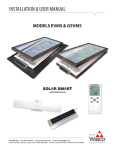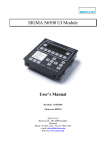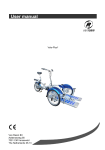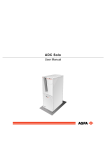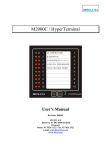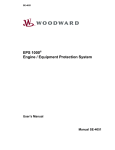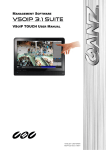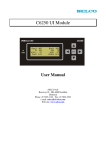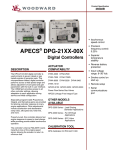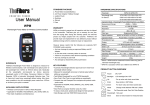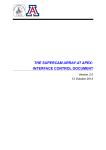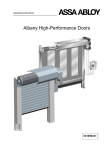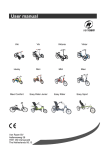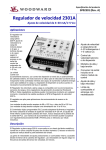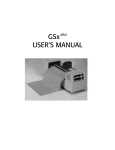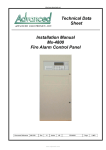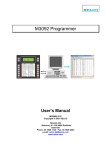Download Interfacing the T4000 & T4400 to Electronic Speed Controllers
Transcript
Interfacing the T4000 & T4400 to Electronic Speed Controllers User’s Manual Revision: 020419 SELCO A/S Betonvej 10 - DK-4000 Roskilde Denmark Phone: 45 7026 1122 - Fax: 45 7026 2522 e-mail: [email protected] www.selco.com Interfacing SELCO T4000 and T4400 to Electronic Speed Controllers Table of Contents 1 2 3 Important Notice....................................................................................................4 Preface..................................................................................................................4 Pre-adjustment......................................................................................................5 3.1 SELCO T4000 Auto-Synchronizer.................................................................5 3.2 SELCO T4400 Load Sharer...........................................................................5 4 Commissioning and Test ......................................................................................5 5 Trouble Shooting...................................................................................................6 6 Barber Colman......................................................................................................8 6.1 DYN1 10504 ..................................................................................................8 6.1.1 Status .....................................................................................................8 6.1.2 Interfacing...............................................................................................8 6.1.3 Connection Diagram...............................................................................8 6.2 DYN1 10654/684/694 ....................................................................................9 6.2.1 Status .....................................................................................................9 6.2.2 Interfacing...............................................................................................9 6.2.3 Connection Diagram...............................................................................9 6.3 DYN1 10754 ................................................................................................10 6.3.1 Status ...................................................................................................10 6.3.2 Interfacing.............................................................................................10 6.3.3 Connection Diagram.............................................................................10 6.4 DYN1 10794 ................................................................................................11 6.4.1 Status ...................................................................................................11 6.4.2 Interfacing.............................................................................................11 6.4.3 Connection Diagram.............................................................................11 7 Cummins.............................................................................................................12 7.1 3037359.......................................................................................................12 7.1.1 Status ...................................................................................................12 7.1.2 Interfacing.............................................................................................12 7.1.3 Connection Diagram.............................................................................12 7.2 3062322 and 3062323.................................................................................13 7.2.1 Status ...................................................................................................13 7.2.2 Interfacing.............................................................................................13 7.2.3 Connection Diagram.............................................................................13 7.3 GSX15, QSK45 and QSK60 ........................................................................14 7.3.1 Status ...................................................................................................14 7.3.2 Interfacing.............................................................................................14 7.3.3 Connection Diagram.............................................................................14 8 Governors America Corp. (GAC) ........................................................................15 8.1 ESD-51xx, ESD-52xx and ESD-55xx ..........................................................15 8.1.1 Status ...................................................................................................15 8.1.2 Interfacing.............................................................................................15 8.1.3 Connection Diagram.............................................................................15 8.2 ESD-53xx.....................................................................................................16 8.2.1 Status ...................................................................................................16 8.2.2 Interfacing.............................................................................................16 8.2.3 Connection Diagram.............................................................................16 9 Heinzmann..........................................................................................................17 9.1 KG6 and KG16 ............................................................................................17 9.1.1 Status ...................................................................................................17 9.1.2 Interfacing.............................................................................................17 9.1.3 Connection Diagram.............................................................................17 10 Synchro-Start ..................................................................................................18 10.1 APECS 4x00 ............................................................................................18 Copyright © 2001 SELCO A/S Page 2 of 22 Interfacing SELCO T4000 and T4400 to Electronic Speed Controllers 10.1.1 Status ...................................................................................................18 10.1.2 Interfacing.............................................................................................18 10.1.3 Connection Diagram.............................................................................18 11 Woodward .......................................................................................................19 11.1 2301A.......................................................................................................19 11.1.1 Status ...................................................................................................19 11.1.2 Interfacing.............................................................................................19 11.1.3 Connection Diagram.............................................................................19 11.2 2301A (with Load Sharer) ........................................................................20 11.2.1 Status ...................................................................................................20 11.2.2 Interfacing.............................................................................................20 11.2.3 Connection Diagram.............................................................................20 11.3 EPG..........................................................................................................21 11.3.1 Status ...................................................................................................21 11.3.2 Interfacing.............................................................................................21 11.3.3 Connection Diagram.............................................................................21 11.4 ST-125 .....................................................................................................22 11.4.1 Status ...................................................................................................22 11.4.2 Interfacing.............................................................................................22 11.4.3 Connection Diagram.............................................................................22 Copyright © 2001 SELCO A/S Page 3 of 22 Interfacing SELCO T4000 and T4400 to Electronic Speed Controllers 1 Important Notice The Variable out 14/16 adjustment on early versions of the T4400 delivered before December 1, 2001 works opposite of what is described within this document. On this early version the Variable Out 14/16 knob must be turned clockwise to decreases the span of the output signal. The Stability adjustment on early versions of the T4400 delivered before April 1, 2002 works opposite of what is described in this document. One this early version the Stability knob must be turned clockwise to decreases stability. 2 Preface This document describes the used of various brands and types of electronic speed controllers together with the SELCO T4000 Auto-Synchronizer and the SELCO T4400 Load Sharer. The SELCO T4000 and SELCO T4400 are designed for direct control of the electronic speed controller, thus no intermediate motorized or electronic potentiometer is required. The direct control improves system speed as the relatively slow ramped control signal is replaced by closed loop regulation with electronic feedback and lead/lag compensation. The schematic diagrams can also be used with the SELCO T4300, however one should note that the output terminals numbers are not the same as on the SELCO T4400. Signal SELCO T4400 SELCO T4300 Output reference Terminal 15 Terminal 15 Non inverted Output Terminal 16 Terminal 16 Inverted Output Terminal 14 Terminal 26 Please note that the SELCO T4400 includes both integrated output and internal frequency control (system frequency stabilisation). These features are not available on the SELCO T4300. Copyright © 2001 SELCO A/S Page 4 of 22 Interfacing SELCO T4000 and T4400 to Electronic Speed Controllers 3 Pre-adjustment 3.1 SELCO T4000 Auto-Synchronizer Phase Angle: Stability: Variable out. 22: Set to tolerated phase angle for closure (e.g. point 6) Set to point 5 for relatively high stability/low adjustment speed Set to 1/3 of maximum for relatively high output voltage span (relatively low resistance between terminal 22 and 21) 3.2 SELCO T4400 Load Sharer Load Dev. %: Diff. Frequency: Stability: Variable out. 14/16: Set to mid point (0%) Set to mid point (0%), also check terminal 29 and 30. Set to point 7 for relatively high stability/low adjustment speed Set to 4/5 of maximum for relatively high output voltage span 4 Commissioning and Test 1. Start up the generators one at a time. The generators must be running without load (with the circuit breaker open). Adjust the speed/frequency setting (Idle) on the speed controller to suit the required system frequency (50 or 60 Hz). 2. Shut down the generators and make sure that the generator AC outputs are not live. 3. Verify that the connections for the voltage and current measurement of the SELCO T4000 and T4400 are connected exactly as described on label located on the top of the units. This is very important. 4. Connect the SELCO T4000 and T4400 according to the schematic diagram included in this document. 5. Pre-adjust the SELCO T4000 and T4400 according to the above directions1. 6. Disconnect the T4000 CLOSE terminals (9 and 10) to avoid automatic closure of the circuit breaker, which is practical during commissioning and test. 7. Start up the generators one at a time (again without load and the circuit breaker open). 8. If necessary, readjust the speed/frequency setting (Idle) on the speed controller to suit the required system frequency (50/60 Hz). The system frequency might have shifted a little due to the impedance properties of the T4400 output circuitry. 9. Reconnect the T4000 CLOSE terminals (9 and 10) to enable automatic closure of the circuit breaker. 10. Start up the first generator and close the circuit breaker to connect it to the common (dead) bus bar. Observe that synchronisation is necessary if the bus bar is live (e.g. when paralleling with the grid or another source). 11. Verify that the system frequency is still correct. If not, return to step 5. 12. Start up the second generator and observe that automatic synchronization and closure of the circuit breaker is performed as expected. 13. Verify that the engine speed and system frequency is stable (and that system frequency is correct). If not, return to step 5. 14. Repeat step 9 to 10 for the remaining generators (if any). 15. Transfer some load to the parallel running generators and observe that any moderate (but sudden) load inflictions do not cause instability or cyclic 1 Be sure to read the notes regarding modifications to the adjustments scheme of the T4400. The notes are printed at beginning of this document. Copyright © 2001 SELCO A/S Page 5 of 22 Interfacing SELCO T4000 and T4400 to Electronic Speed Controllers fluctuations in the engine speed/frequency. If so, increase the stability settings (turn clockwise) on the SELCO T4400 load sharers. It might also be necessary to decrease the strength of the voltage output signal (turn the Variable Out 14/16 dial counter clockwise). 16. Remove some load from the parallel running generators and observe that any moderate (but sudden) load release do not cause instability or cyclic fluctuations in the engine speed/system frequency. If so, increase the stability settings (turn clockwise) of the SELCO T4400 load sharers. It might also be necessary to decrease the strength of the voltage output signal (turn the Variable Out 14/16 dial counter clockwise). 17. Set the load level to about 90% of the capacity of generator number 1 (so that each of the two generators is loaded 45%). Then activate the soft unload function of the SELCO T4400 controlling generator number 2. Observe that generator 2 is slowly unloaded (be careful not to overload generator number 1). You should get a de-loaded trip signal when the load passes beneath approximately 2%. 18. Disable the soft unload function and observe that the load is slowly transferred back to generator 2. 19. Remove the load, trip the generator circuit breakers one at a time and shut down the generators. 5 Trouble Shooting Q: The system becomes unstable when the SELCO T4000 is active. A: Check the connection between the SELCO T4000 and T4400. Make sure that the variable output (terminal 22) on the T4000 is connected to Sync. In. (terminal 9) on the T4400. Also try to decrease the Variable out. 22 signal of the T4000 (turn clockwise to increase resistance between terminal 22 and 21). Q: The generator is shut down on over-speed during start-up. A: The output signal from the T4400 is too strong. Reduce the output signal by turning the Variable Out 14/16 counter clockwise. Q: The load is generally unstable, even when the system is not loaded. A: Check the reference signal of the T4400 (terminal 15). Instruments (e.g. multimeters or scopes) attached between terminal 14/16 and 15 might disturb the output signal. Q: The system becomes unstable when load is transferred to/from the parallel running generators. A: Try to increase the Stability (turn clockwise) on all the SELCO T4400. Stability is a trade-off between regulation speed and system stability. Q: The load fluctuates after the other generator was unloaded. A: Increase Stability (turn clockwise) on the T4400 units. Q: The T4400 appears to react slowly to load fluctuations. Copyright © 2001 SELCO A/S Page 6 of 22 Interfacing SELCO T4000 and T4400 to Electronic Speed Controllers A: Reduce stability or increase the response of the output signal (Turn Stability counter-clockwise). However be careful not to make the system too sensitive. Copyright © 2001 SELCO A/S Page 7 of 22 Interfacing SELCO T4000 and T4400 to Electronic Speed Controllers 6 Barber Colman 6.1 DYN1 10504 6.1.1 Status Assumed similar to Cummins 3037359 6.1.2 Interfacing The auxiliary speed input (terminal 7) of the 10504 controller accepts a signal in the range of +8 to 0 VDC. The output signal of the SELCO T4400 must be adapted in order to fit this range. This is easily done using a voltage divider constructed from two 10 kOhm resistors connected between +8 VDC (terminal 6) and common (terminal ?) on the 10504 controller. The midpoint of the voltage divider (+4 VDC) is then used as a reference for the T4400, which will adapt it’s output range to +8 to 0 VDC (or just about). 6.1.3 Connection Diagram SELCO T4000 and T4400 with Barber Colman DYN1 10504 L1 L2 17 18 19 20 21 22 23 24 25 26 27 28 29 30 31 32 12 13 14 15 16 28 29 30 31 32 12 13 14 15 16 Please contact SELCO regarding connection to other electronic speed controllers. Signal adaption might differ between brand and mark. L3 SELCO T4000 Auto-Synchroniser 1 2 3 4 5 6 7 8 9 10 11 C/B Close C/B 17 18 19 20 21 22 23 24 25 26 27 SELCO T4400 Load Sharer 1 2 3 4 5 6 7 8 9 10 11 7 Diesel Engine 1 0 K COM G 1 0 K 6 Soft Load/Unload Barber Colman DYN1 10504 ACTUATOR PICKUP Copyright © 2001 SELCO A/S ACTUATOR Pickup PICKUP Actuator Page 8 of 22 Interfacing SELCO T4000 and T4400 to Electronic Speed Controllers 6.2 DYN1 10654/684/694 6.2.1 Status Assumed similar to Cummins 3037359 6.2.2 Interfacing The auxiliary speed input (terminal 7) of the 10654/684/694 controller accepts a signal in the range of +8 to 0 VDC. The output signal of the SELCO T4400 must be adapted in order to fit this range. This is easily done using a voltage divider constructed from two 10 kOhm resistors connected between +8 VDC (terminal 6) and common (terminal ?) on the 10654/684/694 controller. The midpoint of the voltage divider (+4 VDC) is then used as a reference for the T4400, which will adapt it’s output range to +8 to 0 VDC (or just about). 6.2.3 Connection Diagram SELCO T4000 and T4400 with Barber Colman DYN1 10654/684/694 L1 L2 17 18 19 20 21 22 23 24 25 26 27 28 29 30 31 32 12 13 14 15 16 28 29 30 31 32 12 13 14 15 16 Please contact SELCO regarding connection to other electronic speed controllers. Signal adaption might differ between brand and mark. L3 SELCO T4000 Auto-Synchroniser 1 2 3 4 5 6 7 8 9 10 11 C/B Close C/B 17 18 19 20 21 22 23 24 25 26 27 SELCO T4400 Load Sharer 1 2 3 4 5 6 7 8 9 10 11 7 Diesel Engine 1 0 K COM G 1 0 K 6 Soft Load/Unload Barber Colman DYN1 10654/684/694 ACTUATOR PICKUP Copyright © 2001 SELCO A/S ACTUATOR Pickup PICKUP Actuator Page 9 of 22 Interfacing SELCO T4000 and T4400 to Electronic Speed Controllers 6.3 DYN1 10754 6.3.1 Status Assumed similar to Cummins 3037359 6.3.2 Interfacing The auxiliary speed input (terminal 7) of the 10754 controller accepts a signal in the range of +8 to 0 VDC. The output signal of the SELCO T4400 must be adapted in order to fit this range. This is easily done using a voltage divider constructed from two 10 kOhm resistors connected between +8 VDC (terminal 6) and common (terminal ?) on the 10754 controller. The midpoint of the voltage divider (+4 VDC) is then used as a reference for the T4400, which will adapt it’s output range to +8 to 0 VDC (or just about). 6.3.3 Connection Diagram SELCO T4000 and T4400 with Barber Colman DYN1 10754 L1 L2 17 18 19 20 21 22 23 24 25 26 27 28 29 30 31 32 12 13 14 15 16 28 29 30 31 32 12 13 14 15 16 Please contact SELCO regarding connection to other electronic speed controllers. Signal adaption might differ between brand and mark. L3 SELCO T4000 Auto-Synchroniser 1 2 3 4 5 6 7 8 9 10 11 C/B Close C/B 17 18 19 20 21 22 23 24 25 26 27 SELCO T4400 Load Sharer 1 2 3 4 5 6 7 8 9 10 11 7 Diesel Engine 1 0 K COM G 1 0 K 6 Soft Load/Unload Barber Colman DYN1 10754 ACTUATOR PICKUP Copyright © 2001 SELCO A/S ACTUATOR Pickup PICKUP Actuator Page 10 of 22 Interfacing SELCO T4000 and T4400 to Electronic Speed Controllers 6.4 DYN1 10794 6.4.1 Status Assumed similar to Cummins 3037359 6.4.2 Interfacing The auxiliary speed input (terminal 9) of the 10794 controller accepts a signal in the range of +8 to 0 VDC. The output signal of the SELCO T4400 must be adapted in order to fit this range. This is easily done using a voltage divider constructed from two 10 kOhm resistors connected between +8 VDC (terminal 7) and common (terminal 11) on the 10794 controller. The midpoint of the voltage divider (+4 VDC) is then used as a reference for the T4400, which will adapt it’s output range to +8 to 0 VDC (or just about). 6.4.3 Connection Diagram SELCO T4000 and T4400 with Barber Colman DYN1 10794 L1 L2 17 18 19 20 21 22 23 24 25 26 27 28 29 30 31 32 12 13 14 15 16 28 29 30 31 32 12 13 14 15 16 Please contact SELCO regarding connection to other electronic speed controllers. Signal adaption might differ between brand and mark. L3 SELCO T4000 Auto-Synchroniser 1 2 3 4 5 6 7 8 9 10 11 C/B Close C/B 17 18 19 20 21 22 23 24 25 26 27 SELCO T4400 Load Sharer 1 2 3 4 5 6 7 8 9 10 11 G 1 0 K 9 11 Diesel Engine 1 0 K 7 Soft Load/Unload Barber Colman DYN1 10794 ACTUATOR PICKUP Copyright © 2001 SELCO A/S ACTUATOR Pickup PICKUP Actuator Page 11 of 22 Interfacing SELCO T4000 and T4400 to Electronic Speed Controllers 7 Cummins 7.1 3037359 7.1.1 Status Confirmed by test. 7.1.2 Interfacing The auxiliary speed input (terminal 9) of the 3037359 controller accepts a signal in the range of +8 to 0 VDC. The output signal of the SELCO T4400 must be adapted in order to fit this range. This is easily done using a voltage divider constructed from two 10 kOhm resistors connected between +8 VDC (terminal 7) and common (terminal 11) on the 3037359 controller. The midpoint of the voltage divider (+4 VDC) is then used as a reference for the T4400, which will adapt it’s output range to +8 to 0 VDC (or just about). 7.1.3 Connection Diagram SELCO T4000 and T4400 with Cummins Controller 3037359 L1 L2 17 18 19 20 21 22 23 24 25 26 27 28 29 30 31 32 12 13 14 15 16 28 29 30 31 32 12 13 14 15 16 Please contact SELCO regarding connection to other electronic speed controllers. Signal adaption might differ between brand and mark. L3 SELCO T4000 Auto-Synchroniser 1 2 3 4 5 6 7 8 9 10 11 C/B Close C/B 17 18 19 20 21 22 23 24 25 26 27 SELCO T4400 Load Sharer 1 2 3 4 5 6 7 8 9 10 11 G 1 0 K 9 11 Diesel Engine 1 0 K 7 Soft Load/Unload Cummins Controller 3037359 ACTUATOR PICKUP Copyright © 2001 SELCO A/S ACTUATOR Pickup PICKUP EFC Page 12 of 22 Interfacing SELCO T4000 and T4400 to Electronic Speed Controllers 7.2 3062322 and 3062323 7.2.1 Status Assumed similar to Cummins 3037359 (however terminals are different) 7.2.2 Interfacing The auxiliary speed input (terminal K/30) of the 3062322/3 controller accepts a signal in the range of +7 to 0 VDC. The output signal of the SELCO T4400 must be adapted in order to fit this range. This is easily done using a voltage divider constructed from two 10 kOhm resistors connected between +7 VDC (terminal H/28) and common (terminal F/12) on the 3062322/3 controller. The midpoint of the voltage divider (+3.5 VDC) is then used as a reference for the T4400, which will adapt it’s output range to +7 to 0 VDC (or just about). 7.2.3 Connection Diagram SELCO T4000 and T4400 with Cummins Controller 3062322 and 3062323 L1 L2 17 18 19 20 21 22 23 24 25 26 27 28 29 30 31 32 12 13 14 15 16 28 29 30 31 32 12 13 14 15 16 Please contact SELCO regarding connection to other electronic speed controllers. Signal adaption might differ between brand and mark. L3 SELCO T4000 Auto-Synchroniser 1 2 3 4 5 6 7 8 9 10 11 C/B Close C/B 17 18 19 20 21 22 23 24 25 26 27 SELCO T4400 Load Sharer 1 2 3 4 5 6 7 8 9 10 11 G F/12 1 0 K K/30 Diesel Engine 1 0 K H/28 Soft Load/Unload Cummins Controller 3062322 and 3062323 ACTUATOR PICKUP Copyright © 2001 SELCO A/S ACTUATOR Pickup PICKUP EFC Page 13 of 22 Interfacing SELCO T4000 and T4400 to Electronic Speed Controllers 7.3 GSX15, QSK45 and QSK60 7.3.1 Status Confirmed by test. 7.3.2 Interfacing The auxiliary speed bias input of the GSX and QSK controllers is accessible through the ECM Connector 03. Connector 03 is a DB25 plug, so it is necessary to solder the wires from the Load Sharer output directly to the pins of the DB25 plug. The QSX and QSK controller can operate with a –2.5 to +2.5 VDC speed bias signal (speed control signal). The +5 VDC reference signal (ECM pin 6) connects to T4400 terminal 15, while the 2,5 VDC speed bias signal (ECM pin 11) connects to T4400 terminal 16. 7.3.3 Connection Diagram SELCO T4000 and T4400 with Cummins QSX15, QSK45 and QSK60 L1 L2 19 20 21 22 23 24 25 26 27 28 29 30 31 32 12 13 14 15 16 28 29 30 31 32 12 13 14 15 16 Please contact SELCO regarding connection to other electronic speed controllers. Signal adaption might differ between brand and mark. 18 Pin 6 17 Pin 11 L3 SELCO T4000 Auto-Synchroniser 1 2 3 4 5 6 7 8 9 10 11 C/B Close C/B 17 18 19 20 21 22 23 24 25 26 27 SELCO T4400 Load Sharer 1 2 3 4 5 6 7 8 9 10 11 Soft Load/Unload G Diesel Engine ECM Connector 03 (DB25) Cummins GSX15, QSK45 and QSK60 PICKUP ACTUATOR Copyright © 2001 SELCO A/S PICKUP Pickup ACTUATOR Actuator Page 14 of 22 Interfacing SELCO T4000 and T4400 to Electronic Speed Controllers 8 Governors America Corp. (GAC) 8.1 ESD-51xx, ESD-52xx and ESD-55xx 8.1.1 Status Confirmed by test. 8.1.2 Interfacing The auxiliary speed input (AUX/N) of the ESD-51xx/52xx accepts a signal in the range of +10 to 0 VDC. The output signal of the SELCO T4400 must be adapted in order to fit this range. This is easily done using a voltage divider constructed from two 10 kOhm resistors connected between +10 VDC (terminal 10V/P) and battery minus (terminal BATTERY-/E) on the GAC speed controller. The midpoint of the voltage divider (+5 VDC) is then used as a reference for the T4400, which will adapt the output range to +10 to 0 VDC (depending on the Variable Out 14/16 setting). 8.1.3 Connection Diagram SELCO T4000 and T4400 with GAC ESD-51xx or 52xx L1 L2 17 18 19 20 21 22 23 24 25 26 27 28 29 30 31 32 12 13 14 15 16 28 29 30 31 32 12 13 14 15 16 Please contact SELCO regarding connection to other electronic speed controllers. Signal adaption might differ between brand and mark. L3 SELCO T4000 Auto-Synchroniser 1 2 3 4 5 6 7 8 9 10 11 C/B Close C/B 17 18 19 20 21 22 23 24 25 26 27 SELCO T4400 Load Sharer 1 2 3 4 5 6 7 8 9 10 11 Soft Load/Unload 1 0 K E (BATT. -) Diesel Engine P (10V) G N (AUX) 1 0 K GAC ESD-51xx or 52xx ACTUATOR PICKUP Copyright © 2001 SELCO A/S ACTUATOR Pickup PICKUP Actuator Page 15 of 22 Interfacing SELCO T4000 and T4400 to Electronic Speed Controllers 8.2 ESD-53xx 8.2.1 Status Control scheme assumed similar to ESD-51xx/52xx (terminals different) 8.2.2 Interfacing The auxiliary speed input (AUX/M) of the ESD-53xx accepts a signal in the range of +10 to 0 VDC. The output signal of the SELCO T4400 must be adapted in order to fit this range. This is easily done using a voltage divider constructed from two 10 kOhm resistors connected between +10 VDC (terminal 10V/L) and battery minus (terminal BATTERY-/C) on the GAC speed controller. The midpoint of the voltage divider (+5 VDC) is then used as a reference for the T4400, which will adapt the output range to +10 to 0 VDC (depending on the Variable Out 14/16 setting). 8.2.3 Connection Diagram SELCO T4000 and T4400 with GAC ESD-53xx L1 L2 17 18 19 20 21 22 23 24 25 26 27 28 29 30 31 32 12 13 14 15 16 28 29 30 31 32 12 13 14 15 16 Please contact SELCO regarding connection to other electronic speed controllers. Signal adaption might differ between brand and mark. L3 SELCO T4000 Auto-Synchroniser 1 2 3 4 5 6 7 8 9 10 11 C/B Close C/B 17 18 19 20 21 22 23 24 25 26 27 SELCO T4400 Load Sharer 1 2 3 4 5 6 7 8 9 10 11 Soft Load/Unload 1 0 K C (BATT. -) Diesel Engine L (10V) G M (AUX) 1 0 K GAC ESD-53xx ACTUATOR PICKUP Copyright © 2001 SELCO A/S ACTUATOR Pickup PICKUP Actuator Page 16 of 22 Interfacing SELCO T4000 and T4400 to Electronic Speed Controllers 9 Heinzmann 9.1 KG6 and KG16 9.1.1 Status Derived for data sheet and application diagram information – not tested. 9.1.2 Interfacing The auxiliary speed input (terminal C3) of the KG6/KG16 controller accepts a plus/minus signal (range unknown but presumed -5 to +5 VDC). The output signal of the SELCO T4400 is standard –6.5 to +6.5 VDC (with the Variable Out 14/16 set to anti-clockwise), thus the T4400 output can be connected directly to the auxiliary speed input of the KG6/KG16 controller. It might be necessary to fine-tune the Variable Out 14/16 adjustment to match the voltage range of the speed controller. 9.1.3 Connection Diagram SELCO T4000 and T4400 with Heinzmann KG6/KG16 L1 L2 19 20 21 22 23 24 25 26 27 28 29 30 31 32 12 13 14 15 16 28 29 30 31 32 12 13 14 15 16 Please contact SELCO regarding connection to other electronic speed controllers. Signal adaption might differ between brand and mark. 18 A3 17 C3 L3 SELCO T4000 Auto-Synchroniser 1 2 3 4 5 6 7 8 9 10 11 C/B Close C/B 17 18 19 20 21 22 23 24 25 26 27 SELCO T4400 Load Sharer 1 2 3 4 5 6 7 8 9 10 11 Soft Load/Unload G Diesel Engine Heinzmann KG6/KG16 ACTUATOR PICKUP Copyright © 2001 SELCO A/S ACTUATOR Pickup PICKUP Actuator Page 17 of 22 Interfacing SELCO T4000 and T4400 to Electronic Speed Controllers 10 Synchro-Start 10.1 APECS 4x00 10.1.1 Status Derived from data sheet and application diagram – not tested. 10.1.2 Interfacing The analogue speed input (terminal 4) of the APECS 4x00 engine governor accepts a signal in the range of 0 VDC to +5 VDC. The output signal of the SELCO T4400 must be adapted in order to fit this range. This is easily done using a voltage divider constructed from two 10 kOhm resistors connected between +5 VDC (terminal 5) and common (terminal 2) on the APECS 4000 controller. The midpoint of the voltage divider (+2.5 VDC) is then used as a reference for the T4400, which will adapt it’s output range to 0 to +5 VDC (or just about). 10.1.3 Connection Diagram SELCO T4000 and T4400 with Synchro-Start APECS 4000 L1 L2 17 18 19 20 21 22 23 24 25 26 27 28 29 30 31 32 12 13 14 15 16 28 29 30 31 32 12 13 14 15 16 Please contact SELCO regarding connection to other electronic speed controllers. Signal adaption might differ between brand and mark. L3 SELCO T4000 Auto-Synchroniser 1 2 3 4 5 6 7 8 9 10 11 C/B Close C/B 17 18 19 20 21 22 23 24 25 26 27 SELCO T4400 Load Sharer 1 2 3 4 5 6 7 8 9 10 11 Soft Load/Unload SRTN 2 Diesel Engine 1 0 K APP 4 G VREF 5 1 0 K Synchro-Start APECS 4000 ACTUATOR PICKUP Copyright © 2001 SELCO A/S ACTUATOR Pickup PICKUP Actuator Page 18 of 22 Interfacing SELCO T4000 and T4400 to Electronic Speed Controllers 11 Woodward 11.1 2301A 11.1.1 Status Derived from information obtained from the Woodward 2301A datasheet. 11.1.2 Interfacing The SPM input (terminal 15) of the 2301A controller accepts a signal in the range of 5 to +5 VDC (equals +/- 3% load shift). The output signal of the SELCO T4400 is standard –6.5 to +6.5 VDC (with the Variable Out 14/16 set to anti-clockwise), thus the T4400 output can be connected directly to the auxiliary speed input of the EPG controller. It might be necessary to fine-tune the Variable Out 14/16 adjustment to match –5 to +5 VDC. Terminal numbers refers to the SPM and COM inputs of the 2301A without internal Load Sharing. 11.1.3 Connection Diagram SELCO T4000 and T4400 with Woodward 2301A L1 L2 19 20 21 22 23 24 25 26 27 28 29 30 31 32 12 13 14 15 16 28 29 30 31 32 12 13 14 15 16 Please contact SELCO regarding connection to other electronic speed controllers. Signal adaption might differ between brand and mark. 18 15 (+/-) 17 16 (COM) L3 SELCO T4000 Auto-Synchroniser 1 2 3 4 5 6 7 8 9 10 11 C/B Close C/B 17 18 19 20 21 22 23 24 25 26 27 SELCO T4400 Load Sharer 1 2 3 4 5 6 7 8 9 10 11 Soft Load/Unload G Diesel Engine ACTUATOR PICKUP ACTUATOR Copyright © 2001 SELCO A/S PICKUP Actuator Pickup SPM Input Woodward 2301A (Version without additional features) Page 19 of 22 Interfacing SELCO T4000 and T4400 to Electronic Speed Controllers 11.2 2301A (with Load Sharer) 11.2.1 Status Derived from information obtained from the Woodward 2301A LS datasheet. 11.2.2 Interfacing The SPM input (terminal 25) of the 2301A controller accepts a signal in the range of 5 to +5 VDC (equals +/- 3% load shift). The output signal of the SELCO T4400 is standard –6.5 to +6.5 VDC (with the Variable Out 14/16 set to anti-clockwise), thus the T4400 output can be connected directly to the auxiliary speed input of the EPG controller. It might be necessary to fine-tune the Variable Out 14/16 adjustment to match –5 to +5 VDC. Terminal numbers refers to the SPM and COM inputs of the 2301A without internal Load Sharing. 11.2.3 Connection Diagram SELCO T4000 and T4400 with Woodward 2301A with LS L1 L2 19 20 21 22 23 24 25 26 27 28 29 30 31 32 12 13 14 15 16 28 29 30 31 32 12 13 14 15 16 Please contact SELCO regarding connection to other electronic speed controllers. Signal adaption might differ between brand and mark. 18 25 (+/-) 17 26 (COM) L3 SELCO T4000 Auto-Synchroniser 1 2 3 4 5 6 7 8 9 10 11 C/B Close C/B 17 18 19 20 21 22 23 24 25 26 27 SELCO T4400 Load Sharer 1 2 3 4 5 6 7 8 9 10 11 Soft Load/Unload G Diesel Engine PICKUP ACTUATOR ACTUATOR Copyright © 2001 SELCO A/S PICKUP Actuator Pickup SPM Input Woodward 2301A (Version with Load Sharer) Page 20 of 22 Interfacing SELCO T4000 and T4400 to Electronic Speed Controllers 11.3 EPG 11.3.1 Status Confirmed by test. 11.3.2 Interfacing The auxiliary speed input (terminal 11) of the EPG controller accepts a signal in the range of -5 to +5 VDC. The output signal of the SELCO T4400 is standard –6.5 to +6.5 VDC (with the Variable Out 14/16 set to anti-clockwise), thus the T4400 output can be connected directly to the auxiliary speed input of the EPG controller. It might be necessary to fine-tune the Variable Out 14/16 adjustment to match –5 to +5 VDC. 11.3.3 Connection Diagram SELCO T4000 and T4400 with Woodward EPG 5xx or 17xx L1 L2 19 20 21 22 23 24 25 26 27 28 29 30 31 32 12 13 14 15 16 28 29 30 31 32 12 13 14 15 16 Please contact SELCO regarding connection to other electronic speed controllers. Signal adaption might differ between brand and mark. 18 12 (-) 17 11 (+) L3 SELCO T4000 Auto-Synchroniser 1 2 3 4 5 6 7 8 9 10 11 C/B Close C/B 17 18 19 20 21 22 23 24 25 26 27 SELCO T4400 Load Sharer 1 2 3 4 5 6 7 8 9 10 11 Soft Load/Unload G Diesel Engine AUX INPUT Woodward EPG 5xx or 17xx ACTUATOR PICKUP ACTUATOR Copyright © 2001 SELCO A/S PICKUP Actuator Pickup Page 21 of 22 Interfacing SELCO T4000 and T4400 to Electronic Speed Controllers 11.4 ST-125 11.4.1 Status Derived from information obtained from the Woodward ST-125 datasheet. 11.4.2 Interfacing The auxiliary speed input (terminal J1-6) of the ST-125 controller accepts a signal in the range of -4.5 to +4.5 VDC. The output signal of the SELCO T4400 is standard – 6.5 to +6.5 VDC (with the Variable Out 14/16 set to anti-clockwise), thus the T4400 output can be connected directly to the auxiliary speed input of the ST-125 controller. It might be necessary to fine-tune the Variable Out 14/16 adjustment to match –4.5 to +4.5 VDC. 11.4.3 Connection Diagram SELCO T4000 and T4400 with Woodward ST-125 L1 L2 19 20 21 22 23 24 25 26 27 28 29 30 31 32 12 13 14 15 16 28 29 30 31 32 12 13 14 15 16 Please contact SELCO regarding connection to other electronic speed controllers. Signal adaption might differ between brand and mark. 18 J1-6 (+/-) 17 J1-7 (COM) L3 SELCO T4000 Auto-Synchroniser 1 2 3 4 5 6 7 8 9 10 11 C/B Close C/B 17 18 19 20 21 22 23 24 25 26 27 SELCO T4400 Load Sharer 1 2 3 4 5 6 7 8 9 10 11 Soft Load/Unload G Diesel Engine 15 PIN AMP Connector Woodward ST-125 ACTUATOR PICKUP Copyright © 2001 SELCO A/S ACTUATOR Pickup PICKUP Actuator Page 22 of 22






















